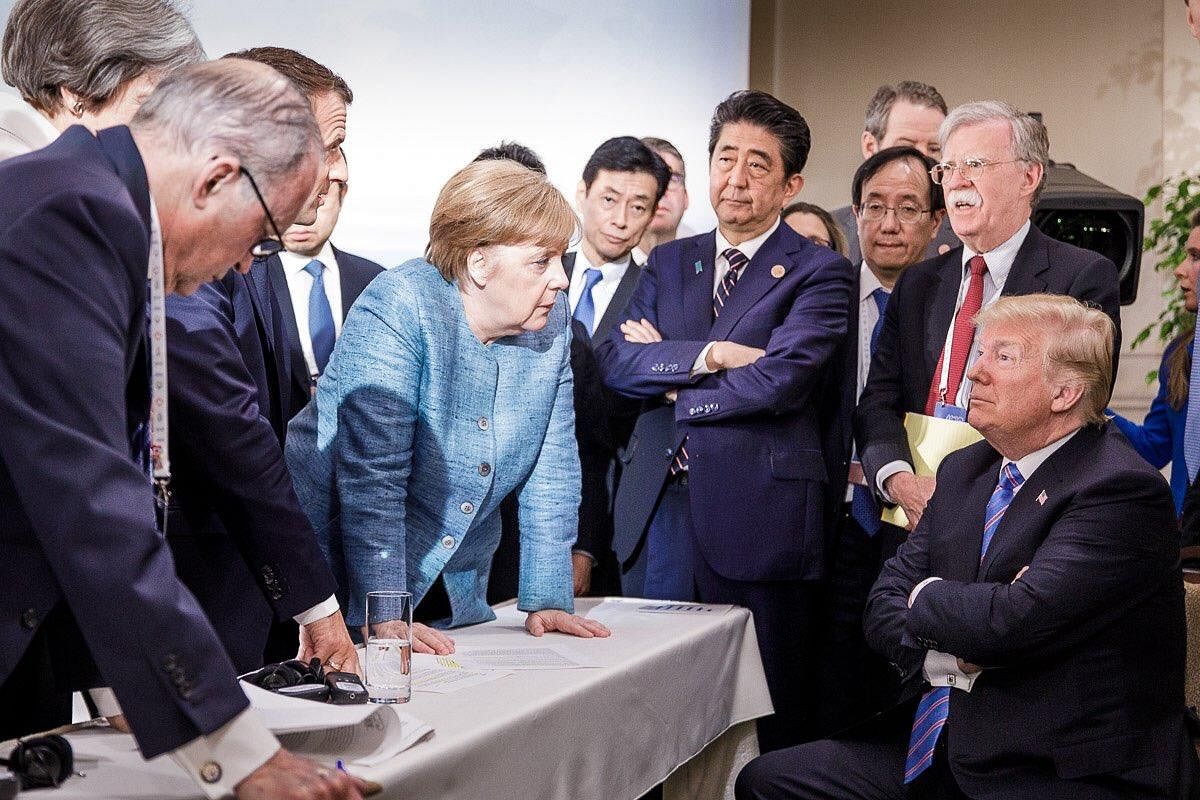Sometimes, pictures and microblogging sites such as twitter pithily convey possibly changing global equations. Over the past few days, three pictures and a series of US President Donald Trump’s tweets effectively did so. These were:
First, a photograph, released by the Germans, of the failed G-7 summit in Canada in which an unmoved Trump, arms crossed, is almost looking through European leaders. Chancellor Merkel of Germany leaning on the table almost in the US President’s face and President Emmanuel Macron of France are clearly visible while British Prime Minister Theresa May, barely seen, is also there. From the side, Japanese Prime Minister Shinzo Abe, whose country is a G-7 member but not the object of Trump’s ire, at least till now, looks on with soft impassiveness.
The photograph illustrates well current US-Europe tensions. Trump sought to explain away the strains evident in the photograph, but they are very much there. Is the Trans-Atlantic Partnership (TAP), that remains largely unfocused on in the media, developing unbridgeable cracks?
Second, on the same day as the G-7 picture, Chinese President Xi Jinping and Russian President Putin at the SCO summit in Qingdao, China. The picture showed their bonding and their joint presence on the global scene. How solid is this growing factor?
Third, Trump and North Korean leader Kim Jong-un in Singapore, sitting together, the ice broken, at the signing of their joint statement indicating a potential breakthrough of a hitherto intractable nuclear proliferation international concern. But, in the end, will anything concrete really happen?
And the tweets: from his plane on way to meet Kim, Trump poured scorn and heaped warnings on Canadian Prime Minister Justin Trudeau. Though he sought to soothe Canada’s pride at his press conference in Singapore, the damage was done. The closest of countries for long, the Canada-US relationship is often held up as an example of neighbourly ties. What is happening to it?
The rise of China and its desire to become a superpower in the same league as the US naturally attracts more media, political and scholarly attention than existing structures that shape the world. Their importance and role in the world, such as in the case of TAP countries, remains unquestionable across a range of issues, including global trade rules and standards of human rights conduct. NATO, which is TAP’s security arrangement, remains an anchor for the security of the West, with a global reach. TAP countries’ contribution to global GDP, trade and capital markets is also enormous.
The TAP continued all through the Cold War because of the common threat of the Soviet Union. Its foundation was based on US leadership and American willingness to share a greater burden of defence expenditure and allow greater access to European goods and services. That position has continued till now, but Trump is insistently calling on the Europeans to pay more for their defence and for a level field in trade in goods and services.
At the same time, he does not seem ready to admit Europe to really participate in decision-making on major international concerns. That has been shown by his moving away from the Iran nuclear deal despite the personal pleas of all European leaders. The same holds good for Trump’s decision to move out of the Paris Climate Change accord.
At the Canada G-7 meeting, Trump hit the Europeans nearer home. He insisted on US duties on aluminium and steel imports from Europe and threatened to levy more on cars. At the same time, he warned Europe against taking reciprocal action. This is an unprecedented hit on European pride and pockets. He further bruised his European peers by suggesting that there should be a re-think on relations with Putin’s Russia, which is under sanctions after the Russian action on Crimea. Finally, Trump publicly disassociated himself from the G-7 Joint Statement, which had been agreed to with an anaemic formulation on trade because of the continuing differences. In doing so, he called Trudeau “dishonest”.
A formidable challenge
Europe is trying to develop an effective multinational force and common diplomatic positions on international issues. However, it simply lacks the wherewithal to manage without the US security umbrella and access to the US market. Despite strong words — this holds for Canada as well — it will have to adapt to Trump’s ways and make offerings at the America First altar. Trump’s domestic critics have severely condemned his treatment of his G-7 colleagues, but his constituents hail him for promoting their interests.
As the Russia-China embrace gets stronger, it is logical for Trump to try to weaken it. That is the reason why he is advocating Russian re-entry into G-7. He has personal interests, too, in Russia. As that relationship is being investigated, he has been inhibited in purposefully going ahead with Russia. The Europeans want to keep Russia boxed in and hence there is a growing distance between Trump and them on this issue. These are likely to cause continuing tension between Russia and the West.
There is no surprise in Trump’s happiness at the Singapore summit, nor in his caution about its ultimate result. This is not the first time that North Korea has agreed to dismantle its nuclear weapons and delivery systems. Now, however, Kim Jong-un is facing severe sanctions and his country’s economic future is bleak. Still, in the joint statement he signed with Trump, he was not willing to go beyond the earlier formulation of committing to the denuclearisation of the Korean peninsula and to work to this end.
Trump has given a commitment of security, but Kim would be aware that assurances or deals can change with changing times as Trump has shown in the Iran case. Kim may therefore be willing to abandon making new bombs and missiles and shutting down facilities for this purpose, but will he give up his existing stock completely? Only time will tell, but it will take a lot to persuade him to do so.
(The writer is former Secretary, Ministry of External Affairs)
